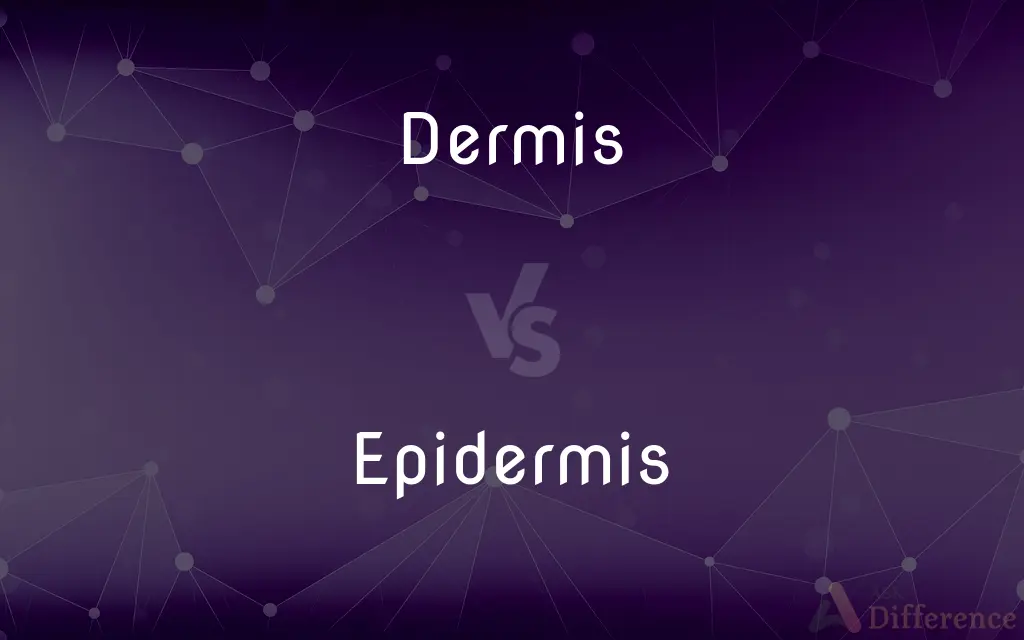Dermis vs. Epidermis — What's the Difference?
Edited by Tayyaba Rehman — By Fiza Rafique — Updated on October 6, 2023
Dermis is the thick, inner layer of the skin. Epidermis is the outermost layer of the skin, serving as a protective barrier.

Difference Between Dermis and Epidermis
Table of Contents
ADVERTISEMENT
Key Differences
Dermis, being the second layer of the skin, holds a vital role in supporting and nourishing the outermost layer, which is the epidermis. The epidermis, while being the outer protective shield of the body, relies heavily on the dermis for sustenance and hydration through the blood vessels found therein.
Rich in collagen fibers, the dermis provides structural integrity and strength to the skin, ensuring elasticity and flexibility. Contrarily, the epidermis, while not directly providing such robust structural support, fortifies the body's first line of defense against external pathogens and harmful ultraviolet radiation.
Within the dermis, numerous appendages such as hair follicles, sweat glands, and sebaceous glands originate, contributing to the multifunctionality of skin. The epidermis, on its side, is devoid of such structures and glands but contributes to skin tone via melanocytes, which protect against UV damage by producing melanin.
Moreover, the dermis is notably responsible for the sensation of touch, due to the presence of nerve endings. The epidermis, while not a conductor of sensations due to the lack of nerve endings, guards the dermis and inner layers against environmental damage with its outermost, dead-cell layer known as the stratum corneum.
In case of an injury, the healing and scarring processes are primarily managed by the fibroblast cells in the dermis. The epidermis, while not directly involved in scar formation, engages in continuous self-renewal, shedding its outermost cells and regenerating from basal cells, ensuring a perpetually protective covering.
ADVERTISEMENT
Comparison Chart
Layer Position
Inner layer of the skin.
Outermost layer of the skin.
Function
Provides strength, elasticity, and sensation.
Offers protection and creates a barrier.
Structures/Glands
Contains hair follicles and various glands.
Lacks glands, has melanocytes.
Sensation
Contains nerve endings for sensation.
Generally lacks nerve endings.
Response to Injury
Engages in healing and may form scars.
Constantly regenerates and sheds cells.
Compare with Definitions
Dermis
Supplies the epidermis with nutrients through blood vessels.
The dermis nourishes the epidermis, ensuring its vitality.
Epidermis
The outer, protective layer of the skin.
The epidermis shields the body from external aggressors.
Dermis
A layer of skin providing structural support and elasticity.
The dermis contains fibroblasts that produce collagen.
Epidermis
Lacks blood vessels and relies on the dermis for nutrients.
The epidermis receives nourishment from the vascular dermis below.
Dermis
Involved in the skin's healing and scarring processes.
Fibroblasts in the dermis contribute to scar formation post-injury.
Epidermis
Contains melanocytes that produce melanin for UV protection.
Melanin in the epidermis helps protect skin from UV radiation.
Dermis
Home to various skin appendages, such as hair follicles and glands.
Sweat glands originating in the dermis help regulate body temperature.
Epidermis
Acts as the body's first line of defense against pathogens.
The epidermis helps prevent bacteria from entering the body.
Dermis
Contains nerve endings that facilitate the sensation of touch.
The dermis sends sensory information to the brain via nerve endings.
Epidermis
Engages in continuous cell renewal and shedding.
The epidermis regenerates, maintaining a protective barrier.
Dermis
The dermis or corium is a layer of skin between the epidermis (with which it makes up the cutis) and subcutaneous tissues, that primarily consists of dense irregular connective tissue and cushions the body from stress and strain. It is divided into two layers, the superficial area adjacent to the epidermis called the papillary region and a deep thicker area known as the reticular dermis.
Epidermis
The epidermis is the outermost of the three layers that make up the skin, the inner layers being the dermis and hypodermis. The epidermis layer provides a barrier to infection from environmental pathogens and regulates the amount of water released from the body into the atmosphere through transepidermal water loss.The epidermis is composed of multiple layers of flattened cells that overlie a base layer (stratum basale) composed of columnar cells arranged perpendicularly.
Dermis
The sensitive connective tissue layer of the skin located below the epidermis, containing nerve endings, sweat and sebaceous glands, and blood and lymph vessels. Also called corium, cutis, derma1.
Epidermis
The outer, protective, nonvascular layer of the skin of vertebrates, covering the dermis.
Dermis
(anatomy) The tissue of the skin underlying the epidermis.
Epidermis
An integument or outer layer of various invertebrates.
Dermis
The deep sensitive layer of the skin beneath the scarfskin or epidermis; - called also true skin, derm, derma, corium, cutis, and enderon. See Skin, and Illust. in Appendix.
Epidermis
The outermost layer of cells covering the leaves and young parts of a plant.
Dermis
The deep vascular inner layer of the skin
Epidermis
The outer, protective layer of the skin of vertebrates, covering the dermis
Epidermis
The similar outer layer of cells in invertebrates and plants
Epidermis
The outer, nonsensitive layer of the skin; cuticle; scarfskin. See Dermis.
Epidermis
The outermost layer of the cells, which covers both surfaces of leaves, and also the surface of stems, when they are first formed. As stems grow old this layer is lost, and never replaced.
Epidermis
The outer layer of the skin covering the exterior body surface of vertebrates
Common Curiosities
Which skin layer regenerates and sheds cells?
The epidermis continuously regenerates and sheds its outer cells.
What is the primary role of the dermis?
The dermis provides structural support, elasticity, and sensation to the skin.
How does the epidermis protect the body?
The epidermis serves as a barrier, protecting against UV rays, pathogens, and dehydration.
Does the dermis contain nerve endings?
Yes, the dermis contains nerve endings that sense touch and temperature.
Is the dermis involved in scar formation?
Yes, the dermis plays a key role in healing and scar formation.
Which layer contains melanocytes and what is their role?
The epidermis contains melanocytes, which produce melanin to protect against UV radiation.
Are hair follicles found in the dermis or epidermis?
Hair follicles originate in the dermis.
What provides the dermis with its elasticity?
The dermis gains elasticity from collagen produced by fibroblasts.
Is the dermis visible to the eye?
No, the dermis is beneath the visible epidermis.
Can the epidermis feel sensations like the dermis?
No, the epidermis generally lacks nerve endings and doesn’t sense touch like the dermis.
Is the epidermis vascular or avascular?
The epidermis is avascular, meaning it lacks blood vessels.
What prevents the epidermis from becoming overly dry?
The stratum corneum, a layer in the epidermis, helps prevent excessive moisture loss.
Can the condition of the dermis affect the appearance of the epidermis?
Yes, the health of the dermis can impact the vibrancy and health of the epidermis.
How does the dermis supply the epidermis with nutrients?
The dermis nourishes the epidermis through its rich supply of blood vessels.
What is the stratum corneum?
The stratum corneum is the outermost layer of the epidermis, consisting mainly of dead cells.
Share Your Discovery

Previous Comparison
Facility vs. Factory
Next Comparison
Adaptation vs. AcclimatizationAuthor Spotlight
Written by
Fiza RafiqueFiza Rafique is a skilled content writer at AskDifference.com, where she meticulously refines and enhances written pieces. Drawing from her vast editorial expertise, Fiza ensures clarity, accuracy, and precision in every article. Passionate about language, she continually seeks to elevate the quality of content for readers worldwide.
Edited by
Tayyaba RehmanTayyaba Rehman is a distinguished writer, currently serving as a primary contributor to askdifference.com. As a researcher in semantics and etymology, Tayyaba's passion for the complexity of languages and their distinctions has found a perfect home on the platform. Tayyaba delves into the intricacies of language, distinguishing between commonly confused words and phrases, thereby providing clarity for readers worldwide.














































